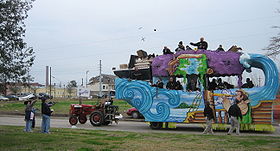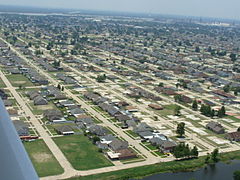View of Chalmette residential area
Chalmette is a census-designated place (CDP) in and the parish seat of St. Bernard Parish, in southeast Louisiana, United States. The 2010 census reported that Chalmette had 16,751 people and is 76 percent white. The 2011 population is listed as 17,119; however, the pre-Katrina population was 32,069 at the 2000 census. The population hence declined by 46 percent between 2000 and 2010. Chalmette is part of the New Orleans–Metairie–Kenner Metropolitan Statistical Area. Chalmette is located east of downtown New Orleans and south of Arabi, Louisiana, towards Lake Borgne.
The community was named after plantation owner Louis-Xavier Martin de Lino de Chalmette (1720-1755), whose surname is, in turn, derived from the French word "chalmette" (meaning "pasture land, fallow land") and has been traced to the Proto-Celtic word "*kalm".
History
Chalmette was founded by plantation owner Louis-Xavier Martin de Lino de Chalmette (1720-1755), a native of Quebec and grandson of René-Louis Chartier de Lotbinière of Maison Lotbinière. His eldest son, Louis Xavier Martin de Lino de Chalmette (1753-1814) was born there and later married the sister of Antoine Philippe de Marigny, grandfather of Bernard de Marigny.In January 1815, the Battle of New Orleans was fought at Chalmette on the founder's plantation, now owned by his second son, Ignace Martin de Lino de Chalmette (1755-1815), a first cousin of Major-General Pierre Denys de La Ronde (1762-1824), the founder of Versailles, who commanded the Louisiana militia during the battle. The United States forces under Major General Andrew Jackson defeated the British, led by brevet Lieutenant General Sir Edward Pakenham. The battlefield is preserved as a national monument, and the military Chalmette National Cemetery is adjacent.
Hurricane Katrina
On 29 August 2005, the 25-foot (7.6 m) storm surge from Hurricane Katrina overflowed through the Mississippi River – Gulf Outlet Canal (also commonly known as MRGO) - a commercial channel dug by the United States Army Corps of Engineers in the 1960's - and flooded most of the town, with waters as high as 14 to 15 feet (4.9 m) in some places. As a result, Chalmette was extensively swamped and nearly destroyed. A majority of the population evacuated shortly before the storm hit, but there was still significant loss of life.As of 25 October 2005, most of the buildings were deemed unsaveable. Despite findings published by the U.S. EPA, the toxic chemicals in the water from local oil refineries have been postulated to be an ongoing health hazard by several civilian ecological groups. Especially notable was the large oil spill originating in Chalmette's large Murphy Oil facility, where the storm surge knocked over a huge oil tank (see photo below).
The parish administrative headquarters served as the site for a Federal Emergency Management Agency (FEMA) trailer park for numerous civil servants who were laboring in the rebuilding effort. A year later, parish employees were still working shifts around the clock to bring the community back to life.
Another center in the rebuilding effort was centered at the church of Our Lady of Prompt Succor, which served the congregations of the seven other Roman Catholic parishes as well as the main office of Catholic Relief Services. It also served as the only place to hold funerals for the first 12 months after Katrina.
"Camp Premier", renamed "Camp Hope", was established as a base camp for the community rebuilding efforts, facilitating the work of relief organizations, the National Guard and private individuals. As of August 2007, the camp is located to P.G.T. Beauregard Middle School and is operated by Habitat for Humanity to provide for relief volunteers in St. Bernard Parish. Other relief organizations, such as the St. Bernard Project, have also participated in the rebuilding of Chalmette, from distributing supplies, to clearing debris, to preparing damaged houses for homeowners to return.
The Chalmette Battlefield was also partially flooded in low-lying areas, destroying the Visitor's Center, which was removed for rebuilding, and temporarily replaced with a house trailer to attempt re-opening the park for visitors in 2007.

Gradual recovery
St. Bernard Parish has celebrated Mardi Gras with parades in Chalmette. In February 2006, the krewe of the Knights of Nemesis held a parade, past many buildings still in ruins, along the streets of Chalmette.As of early 2008, many businesses have returned to the area, schools have reopened, although the population remains significantly below pre-Katrina levels.
Due to Hurricane Katrina, the St. Bernard Parish School Board succeeded in getting a school open despite considerable difficulties, including telling FEMA that it would not wait for the agency. The parish opened the St. Bernard Unified School as a K-12 school in late 2005.
With the opening of the 2006-2007 school year, the Unified school reverted to Chalmette High School and now houses grades 8-12. The former Andrew Jackson High School has been repaired and now houses grades PK3-5. Trist Middle School houses grades 6 through 7.
The Catholic and private school sector was lost to Katrina. The archdiocese of New Orleans has consolidated all local schools into one, on the Our Lady of Prompt Succor campus. It has grades PK-8.
Education
Chalmette is served by the St. Bernard Parish Public Schools district. As of 2007, Chalmette is served by schools in unincorporated areas:- Andrew Jackson Elementary School (in Chalmette)
- Trist Middle School (in the community of Meraux)
- Chalmette High School (in Chalmette)
Private schools include:
- Our Lady of Prompt Succor Catholic School (K-8)
- C.F. Rowley Elementary School
- Joseph J. Davies Elementary School
- Lacoste Elementary School
- Lynn Oaks (K-7)
- Trist Middle School
- Chalmette Middle School
- Chalmette Senior High School
- Andrew Jackson Fundamental Magnet High School (now the site of Andrew Jackson Elementary School, soon to be Andrew Jackson Middle School)
- St. Bernard High School
- Carolyn Park Elementary
- Arabi Elementary
- Arabi Park Middle
- Saint Mark Elementary
- Saint Louise de Marilac Elementary
- Sebastion Roy Elementary
- Millaudon Elementary
- P.G.T Beauregard
- One In Christ Academy (Pre-K-8)
- Archbishop Hannan High School
- Saint Robert Bellarmine Catholic School (Pre-K- 8)
Notable residents
- Norris Weese, quarterback for Ole Miss and the Denver Broncos
- Tommy Wiseau, director of the cult classic The Room, often described as one of the worst movies ever made
External Links
- Andrew Jackson Fundamental Magnet High School
- Chalmette High School
- Chalmette National Cemetery
- Nita Rusich Hutter
- Samuel B. Nunez, Jr.
- Leander Perez
- Jean Lafitte National Historical Park and Preserve
- The Colony U.S. TV series
- Chalmette Battlefield - Visitor Information: from National Park Service, nps.gov.
- Chalmette photos after Hurricane Katrina, photos of Katrina damage in Wikimedia Commons.
- Chalmette photos after Hurricane Katrina on KatrinaDestruction.com, from late September 2005.





